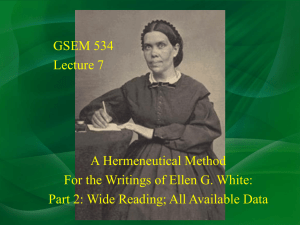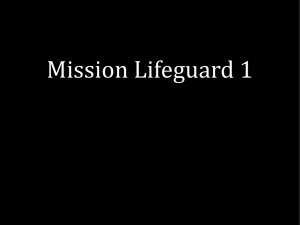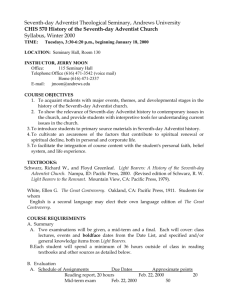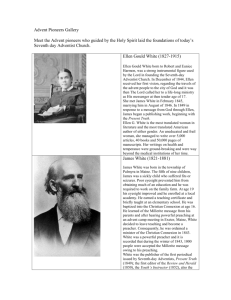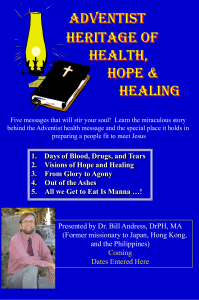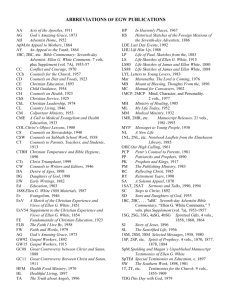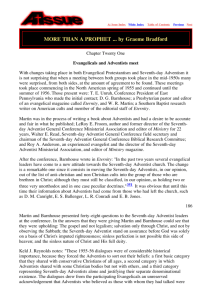Mission`s New Frontier
advertisement
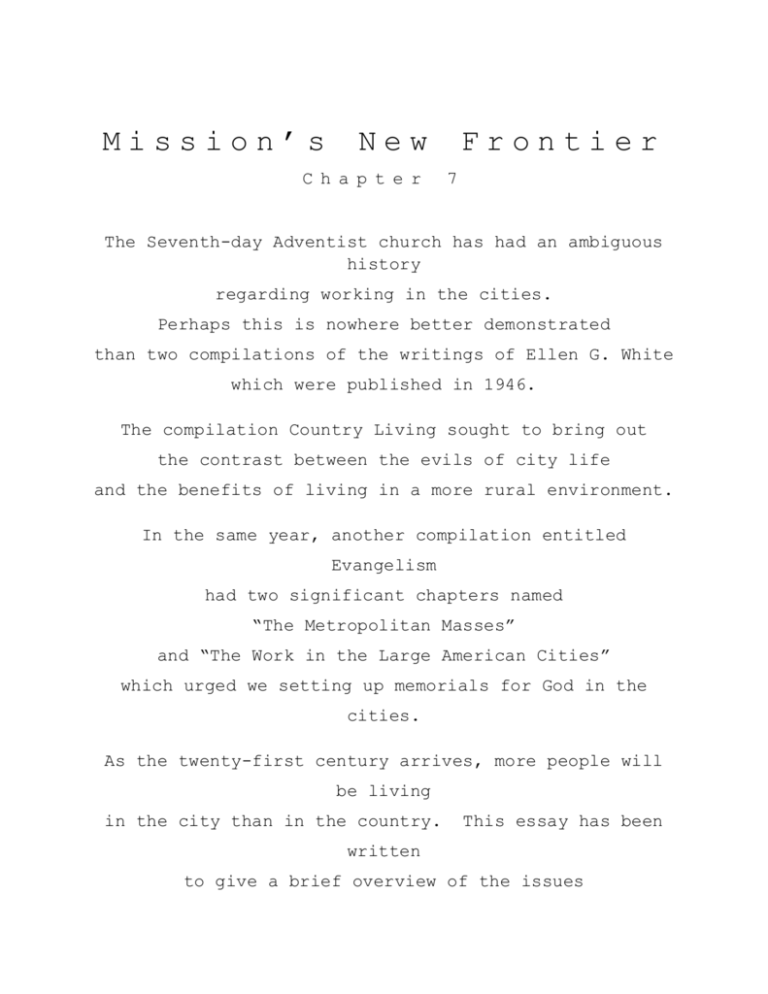
Mission’s New C h a p t e r Frontier 7 The Seventh-day Adventist church has had an ambiguous history regarding working in the cities. Perhaps this is nowhere better demonstrated than two compilations of the writings of Ellen G. White which were published in 1946. The compilation Country Living sought to bring out the contrast between the evils of city life and the benefits of living in a more rural environment. In the same year, another compilation entitled Evangelism had two significant chapters named “The Metropolitan Masses” and “The Work in the Large American Cities” which urged we setting up memorials for God in the cities. As the twenty-first century arrives, more people will be living in the city than in the country. This essay has been written to give a brief overview of the issues surrounding the tension between rural living and urban evangelism The Secular City Harvie Conn, a leading urban missions expert, writes that an executive at a meeting of the Evangelical Foreign Missions Association once said to him: “God made the country and man made the suburb. But the devil made the city.”1 Evangelicals have always had an aversion towards work in the urban jungle. After limited success, Dwight L. Moody lamented big city evangelism in 1896 by saying of New York city: “If it was not for the work I am called to do, I would never show my head in this city or any other again.”2 In fact the age-old vision of the city as an evil place goes clear back to the second century A.D. when Juvenal lamented: “‘What can I do in Rome?’ he asked. ‘I have never 3 learned to lie.’” The inevitable tension between the otherworldly, Holy city of God and the worldly, secular city of man is typified by the scolding of a monk by Jerome in A.D. 374. The monk had for abandoned the life in seclusion for the lures of the city and Jerome encouraged him to return to the beauties of the desert: O wasteland bright with the spring flowers of Christ! O solitude out of which come these stones that build the city of the great King in the Apocalypse! O desolate desert rejoicing in God’s familiar presence! what keeps you in the world, O brother? You are above and beyond the world. How long is the shade of the house going to conceal you? How long shall the grimy prisons of those cities intern you.4 A more modern assessment is expressed by Jacques Ellul in his book The Meaning of the City: “Like a vampire, it preys on the true living creation, alive in its connection with the Creator. The city is dead, made of dead things for dead 5 people.” In the middle of the twentieth century the church was still not equipped to meet this complex new mission field as witnessed by this statement which summarized the spread of Christianity during the previous one hundred years: “There are three great areas of our world which the churches have not really penetrated. They are: Hinduism, Islam and the culture of modern cities.”6 The Seventh-day Adventist church has also had an ambiguous history and position regarding urban missiology. Perhaps this is nowhere better demonstrated than two compilations of the writings of Ellen G. White which came out in 1946. In the foreword to Country Living the following statement appears from the Ellen G. White Estate Trustees: The advantages of country living have been repeatedly stressed through the Spirit of Prophecy counsels. The gathering storm clouds signalize the appropriateness of resounding the call to leave the cities. It must be evident to every thoughtful Seventh-day Adventist that city living, with its congestion, allurements, and mounting labor conflicts, does not provide a wholesome environment for christian families.7 In another volume entitled Evangelism published that same year, two significant chapters appear named “The Metropolitan Masses” and “The Work in the Large American Cities.” latter chapter this paragraph appears: In the Those who bear the burden of the work in Greater New York should have the help of the best workers that can be secured. Here let a center for God's work be made, and let all that is done be a symbol of the work the Lord desires to see done in the world.8 The objective of reaching the expanding American cities on the Eastern seaboard with the highly receptive immigrant peoples from Europe at the turn of the 20th century was finally reached only after an intense struggle.9 Jon Dybdahl, who is the current Director of the Institute of World Mission at Andrews University, reflects the struggle to reach the cities by saying: “Traditionally, many Adventists tend to avoid or fear the cities. Consequently, in many parts of the world, our work in the cities is weak. We must find ways to claim the cities for 10 Christ.” And Adventist urban missions specialist Bruce Moyer recently commented: “If the Adventist Church does not meet the challenge of the cities, particularly in the Third World, it may find itself speaking to very few people.”11 Rural Outposts and Urban Mission The twenty first century presents a new and emerging challenge for the mission frontier has changed from the rural outpost to the urban jungle. In this century alone, the people in cities has rapidly grown from fourteen percent in 1900 to fifty-five percent at the beginning of the new millennia.12 For the first time in recorded history, more people live in the cities than in the countryside. The emerging, world-wide reality of the growth of cities presents a special challenge to the Seventh-day Adventist Church. While we are on the one hand counseled to keep ourselves from the world, the world we are to warn is increasingly found in the cities. There are several important factors which have led to the stressing of the rural over the urban in Adventists mission work: • The Seventh-day Adventist Church grew out of the rural milieu of the 19th Century. • The city has almost always been pictured as the epitome of evil and worldliness whereas the country has been seen as idealic in nature. • The call to “leave the cities” and setup outpost centers has usually been interpreted in a narrow and often ineffective way. In the compilation entitled Country Living by Ellen White, there appears the following statement concerning institutions of the SDA church should be located: where As far as possible, our institutions should be located away from the cities. We must have workers for these institutions, and if they are located in the city, that means that families of our people must settle the near them. But it is not God's will that His people shall settle in the cities, where there is constant turmoil and confusion. Their children should be spared this; for the whole system is demoralized by the hurry and rush and noise. The Lord desires His people to move into the country, where they can settle on the land, and raise their own fruit and vegetables, and where their children can be brought in direct contact with the works of God in nature. Take your families away from the cities is my message.13 Some in the church have taken this and other statements to show that all Seventh-day Adventists should move out of the cities. However, a careful reading reveals that only institutions and not churches are mentioned. A question needs to be asked over the possible distinction between the inner city where “turmoil,” “confusion” and “noise” exist and a relatively quiet suburb. When Ellen White penned the above statement in 1902 suburbs did not exist. Harvie Conn, in his book The American City and the Evangelical Church points out that housing reformers at the turn of the century themselves saw that the “overcrowding in the downtown areas was the handmaiden of crime and poverty. Henry Ford predicted, ‘The city is doomed . . . We shall solve the city problem by leaving the city [by means of the automobile]. Everywhere new suburbs sprouted in support of these 14 prophecies.” It took two generations for suburbia to become the dominant percentage of the American population: “In 1920, city dwellers became a majority of the population. In 1970 another milestone was marked; more Americans were living in the suburbs than in the cities.”15 Within the last decade three major institutions have moved to more rural places in harmony with this counsel. The Pacific Press, which was located in Mountain View, California, was moved to the more sparsely populated and affordable housing area of Nampa Idaho. The General Conference headquarters and the Review and Herald Publishing Association were transferred out of the heart of Washington DC to the more suburban settings of Silver Springs and Hagerstown Maryland. The hesitancy to tackle the difficulties of working in the large cities by the early SDA church and how it was resolved is recorded in this most revealing passage from the pen of inspiration: I dreamed that several of our brethren were in council, considering plans of labor for this season [1874]. They thought it best not to enter the large cities, but to begin work in small places, remote from the cities; here they would meet less opposition from the clergy, and would avoid great expense. They reasoned that our ministers, being few in number, could not be spared to instruct and care for those who might accept the truth in the cities, and who, because of the greater opposition they would there meet, would need more help than would the churches in small country places. Thus the fruit of giving a course of lectures in the city would, in a great measure, be lost. Again, it was urged that, because of our limited means, and because of the many changes from moving that might be expected from a church in a large city, it would be difficult to build up a church that would be a strength to the cause. My husband was urging the brethren to make broader plans without delay, and put forth, in our large cities, extended and thorough effort, that would better correspond to the character of our message. One worker related incidents of his experience in the cities, showing that the work was nearly a failure, but he testified to better success in the small places. One of dignity and authority--One who is present in all our council meetings--was listening with deepest interest to every word. He spoke with deliberation and perfect assurance. "The whole world," He said, "is God's great vineyard. The cities and villages constitute a part of that vineyard. These must be worked."16 If the Seventh-day Adventist Church is to be more effective in its prophetic ministry to the masses of people around us, it must find a way to resolve the issue between rural outposts and city missions. And in our attempts to find a satisfactory answer we must ultimately follow the example of Jesus, who left His safe home to minister to our sin-filled world without becoming corrupted by its influence. The next section provides perhaps one component of the answer by briefly outlining how Ellen White describes both the church and its ministry to the world in terms of a “city.” The City of Refuge In the important first chapter of the book, Acts of the Apostles, entitled “God’s Purpose for His Church,” Ellen G. White begins by stating: “The church is God's appointed agency for the salvation of men. It was organized for service, and its mission is to carry the gospel to the world.”17 Within this first chapter, the word “city” is used three times–twice to describe the church and once to picture the world. “The city of refuge” is the first image of the church presented in the chapter: The church is God's fortress. His city of refuge, which He holds in a revolted world. Any betrayal of the church is treachery to Him who has bought mankind with the blood of His only-begotten Son. From the beginning, faithful souls have constituted the church on earth. In every age the Lord has had His watchmen, who have borne a faithful testimony to the generation in which they lived. These sentinels gave the message of warning; and when they were called to lay off their armor, others took up the work. God brought these witnesses into covenant relation with Himself, uniting the church on earth with the church in heaven. He has sent forth His angels to minister to His church, and the gates of hell have not been able to prevail against His people.18 Fortress, refuge, safety. Yes, the church is to provide a sense of security for those who have gathered within her walls. But a careful reading of the paragraph shows that those gathered are not to be cloistered together for their benefit alone but are to be “watchmen” “sentinels” and “witnesses” to those who are wandering in the insecure, guilt-ridden darkness. A wonderful balance between refuge for the purpose of soulwinning is revealed in this first picture of the church. The City Set on a Hill The second image of the church is “the city set on a hill” imagery when Jesus taught us during the Sermon on the Mount that: “You are the light of the world. A city on a hill cannot be hidden. Neither do people light a lamp and put it under a bowl. Instead they put it on its stand, and it gives light to everyone in the house. In the same way, let your light shine before men, that they may see your good deeds and praise your Father in heaven” (Matthew 5:13-16). Ellen White takes this figure and again applies it in a dual way to the church. God unfolds the pure doctrines of heaven within its borders and makes the church the theater of His grace in order to reveal His power to transform hearts. The glow of God’s love from His holy hill serves as a beacon light to those who are in the dark. During ages of spiritual darkness the church of God has been as a city set on a hill. From age to age, through successive generations, the pure doctrines of heaven have been unfolding within its borders. Enfeebled and defective as it may appear, the church is the one object upon which God bestows in a special sense His supreme regard. It is the theater of His grace, in which He delights to reveal His power to transform hearts.19 The City in the Wilderness The third time the word city is used in the opening chapter of Acts of the Apostles describes the mission of the church to the “cities of the wilderness.” The Jewish leaders thought themselves too wise to need instruction, too righteous to need salvation, too highly honored to need the honor that comes from Christ. The Saviour turned from them to entrust to others the privileges they had abused and the work they had slighted. God's glory must be revealed, His word established. Christ's kingdom must be set up in the world. The salvation of God must be made known in the cities of the wilderness; and the disciples were called to do the work that the Jewish leaders had failed to do.20 God’s glory, His word, Christ’s kingdom must be revealed to the cities in the wilderness. Our privileges must not be abused nor our work slighted The salvation of God must be made known to the pilgrims who are gathering in the great cities of the earth. And from song number 356 found in the Seventh-day Adventist hymnal, the call goes forth to “All Who Love and Serve Your City” to be willing Jonahs and show the Lord’s love and compassion to those who know Him not. All who love and serve your city, All who bear its daily stress, All who cry for peace and justice, All who curse and all who bless. In your day of loss and sorrow, In your day of helpless strife, Honor, peace, and love retreating, Seek the Lord, who is your life. For all days are days of judgment, And the Lord is waiting still, Drawing near His friends who spurn Him, Offering peace from Calvary’s hill. Risen Lord, shall yet the city, Be the city of despair? Come today, our judge, our glory; Be its name “The Lord is there!”21 Summary The story of redemption begins in a garden and ends in a glorious city. If the Seventh-day Adventist Church is going to be effective in the twenty-first century then it must seek to resolve the issue between rural outposts and city missions. Throughout the Scriptures, the gathering of God’s people is often likened to a city. In the Sermon on the Mount, Jesus taught His people were to be like “a city built on a hill cannot be hid” (Matthew 5:14). Unity must also be maintained in the Kingdom for, “no city or house divided against itself will stand” (Matthew 12:25). The world has also gathered its pilgrims together in cities of rebellion. Her freeways are filled with the lost. And like the great Assyrian city of old, God is heard pleading with His oft reluctant church: “Should I not be concerned about that great city” (Jonah 4:11)? Endnotes 1. Harvie Conn, A Clarified Vision for Urban Mission, Rapids: Zondervan, 1987), pg. 20. 2. 3. Church, (Grand Ibid., page 26. Harvie Conn, The American City and the Evangelical (Grand Rapids: Baker Books, 1994), page 9. 4. Harvie Conn, “The Kingdom of God and the City of God: A History of the City/church Dialogue,” in Roger Greenway, editor, Discipling the City. 2nd edition, (Grand Rapids: Baker Books, 1992), page 247. 5. Ellul, Jacques, The Meaning of the City, (Grand Rapids: Eerdmans, 1970), page 150. 6. Schaller, Lyle, ed. , Center City Churches, (Nashville, TN: Abingdon Press, 1993), pg. 11. 7. Ellen White, Country Living, (Washington D.C.: Review & Herald, 1946), page 3. 8. Ellen White, Evangelism, (Washington D.C.: Review & Herald, 1946), pages 384-385. 9. Howard Weeks, Adventist Evangelism in the Twentieth Century, (Washington D.C.: Review & Herald, 1969), pages 27-42. 10. Jon Dybdahl, Exploring the Challenges, Adventist Review 172, 23:12, 1995. 11. Bruce Moyer, “The Challenge of the Cities,” Ministry 85, 1992, page 49. 12. Eugene Rubingh, Strategies for Evanglization in Cities, (Grand Rapids: Centennial Missions Scholarship Committee, 1986), page 16. 13. Ellen White, Country Living, (Washington D.C.: Review & Herald, 1946), pages 29-30. . 14. Harvie Conn, The American City and the Evangelical Church, (Grand Rapids: Baker Books, 1994), page 77. 15. Ibid., page 83. 16. Ellen White, Testimonies for the Church, Volume (Washington D.C.: Review & Herald, 1946), pages 34-35. 7, 17. Ellen White, Acts of the Apostles, (Mountain View, CA: Pacific Press, 1911), page 9. 18. Ibid., page 11. 19. Ibid., page 12. 20. Ibid., page 16. 21. Charles L. Brooks, Chairman, The Seventh-day Adventist Hymnal, (Washington D.C.: Review & Herald, 1985), page 356.

